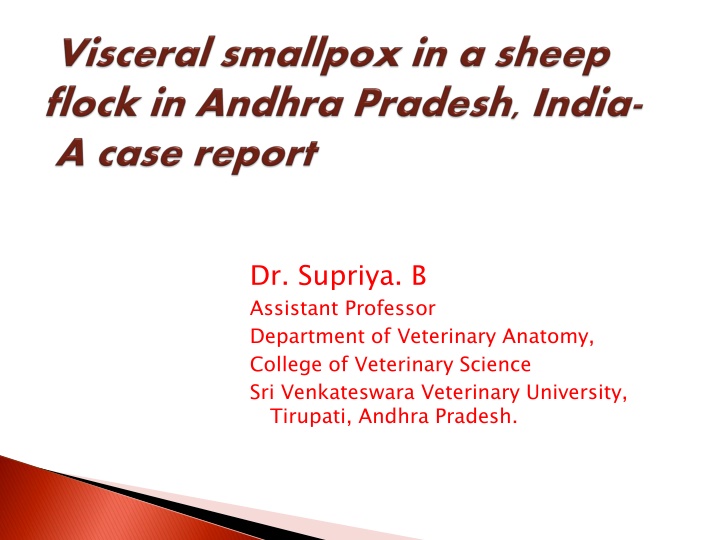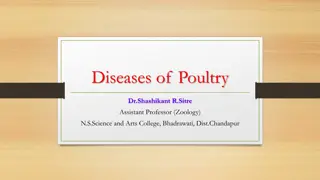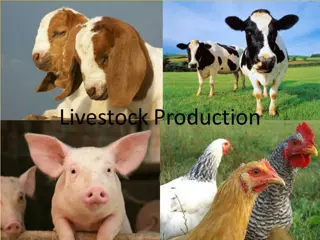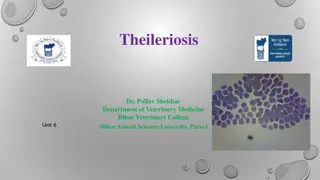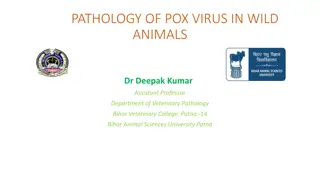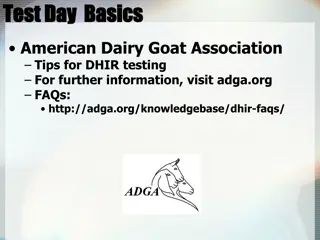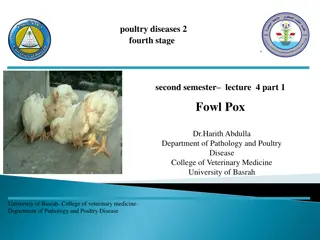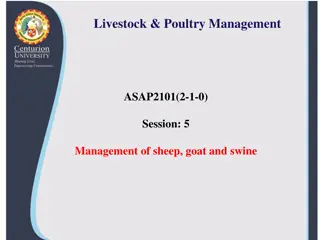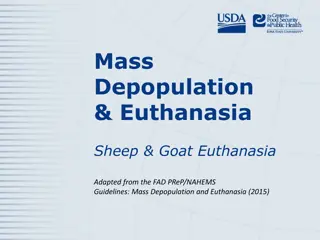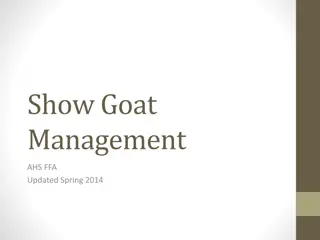Sheep and Goat Pox: Causes, Symptoms, and Prevention
Sheep and goat pox are contagious viral diseases affecting small ruminants with high mortality rates and various clinical manifestations. The diseases are mainly prevalent in specific regions and can be transmitted through aerosols, contact with infected materials, and insect vectors. Understanding the characteristics of these diseases is crucial for effective prevention and control measures.
Download Presentation

Please find below an Image/Link to download the presentation.
The content on the website is provided AS IS for your information and personal use only. It may not be sold, licensed, or shared on other websites without obtaining consent from the author.If you encounter any issues during the download, it is possible that the publisher has removed the file from their server.
You are allowed to download the files provided on this website for personal or commercial use, subject to the condition that they are used lawfully. All files are the property of their respective owners.
The content on the website is provided AS IS for your information and personal use only. It may not be sold, licensed, or shared on other websites without obtaining consent from the author.
E N D
Presentation Transcript
Dr. Supriya. B Assistant Professor Department of Veterinary Anatomy, College of Veterinary Science Sri Venkateswara Veterinary University, Tirupati, Andhra Pradesh.
Sheep and goat pox are contagious viral diseases of small ruminants. The virus can replicate in cattle but does not cause clinical disease. The disease has not been detected in wild ungulate populations. Family Pox viridae Subfamily Chordopox virinae Genus Capripox virus These diseases may be mild in indigenous breeds living in endemic areas, but are often fatal in newly introduced animals. Incubation Period :4 to 21 days
Temperature: Susceptible to 56C/2 hours; 65C/30 minutes. Some isolates inactivated at 56 C/60 minutes pH: Susceptible to highly alkaline or acid pH Disinfectants/chemicals: Inactivated by phenol (2%) in 15 minutes. Sensitive to detergents, ether (20%), chloroform, formalin (1%), and sodium hypochlorite (2-3%), iodine compounds (1:33 dilution), quarternary ammonium compounds 0.5%. Survival: Susceptible to sunlight, but remains viable in wool/hair and dry scabs on skin for up to 3 months. Persists in unclean shaded pens for as long as 6 months. Survives freeze thaw cycles, but infectivity may be reduced .
High mortality Reduced milk yield Decreased weight gain Increased abortion rates Damage to wool and hides Increased susceptibility to pneumonia and fly strike Restriction of the export of meat, wool and skin
Mainly susceptible host are sheep, goats, buffaloes, cow, horse, swine, fowl as well as human beings also. Worldwide distribution. Sheep and goat pox is highly contagious and enzootic prevalent in north and central Africa, India, Bangladesh and middle eastern countries, china.
Aerosol transmission Contact with infected wool or bedding Insect vectors biting flies mosquitoes likely can act as vectors but it is not proven Virus is stable in the environment for weeks Ulcers on the mucous membranes are important sources of virus.
Fever lymphnode swelling, Edema of the eyelids, Nasal discharge, Inappetence, lacrimation, Coughing, Salivation . Breathing became laboured and noisy due to pressure on the upper respiratory tract from the swollen retro- pharyngeal lymph nodes, due to the developing lung lesions. This animal died of acute infection before the development of skin lesions In Papulovesicular form of the disease was not observed.
The autopsy of the animals with visceral smallpox revealed extensive pock lesions along the length of trachea, on the heart and lungs.
Numerous hard lesions of up to 2 cm in diameter were observed throughout the lungs.
Lesions in trachea
Trachea lung lymph node Buffy coat from blood Blood in heparin or EDTA Skin Samples for virus isolation must be sent to the laboratory as soon as possible. They should be kept cold and shipped on wet ice or gel packs. If these samples must be shipped long distances without refrigeration, glycerol (10%) can be added. The tissue samples must be large enough that the medium does not penetrate into the center of the tissue and destroy the viruses there.
History Clinical signs Autopsy Polymerase chain reaction Histopathology Transmission electron microscope Animal inoculation Fluorescent antibody tests Agar gel immunodiffusion test (AGID) Enzyme-linked immunosorbent assay (ELISA) Virus neutralisation Indirect fluorescent antibody test Western blot analysis
Parasitic pneumonia Contagious ecthyma (orf) Insect bites Bluetongue Peste des petits ruminants Photosensitisation Dermatophilosis Caseous lymphadenitis Mange
Antibiotic Anti inflammatory B- complex Gruels, chopped tender leaves feeding
If culling is not possible, isolation of infected herds and sick animals for at least 45 days after recovery. Slaughtering of infected herd if possible Proper disposal of cadavers and products - burning or burial is often used Stringent cleaning and disinfection of farms and equipment. Quarantine of new animals before introduction into herds. Animal and vehicle movement controls within infected areas. Vaccination may be considered when the disease has spread more widely.
Sheep Pox Vaccine Composition: Raksha - SP vaccine contains live attenuated sheep pox virus grown on primary lamb testicle cell culture and freeze dried. The virus is comprised of Romanian strain. The Kenya O 180 strain is possibly the vaccine with the best safety and efficacy.
Sheep and goat pox can limit trade and prevent the development of intensive livestock production. Capripox viruses have the potential to become emerging disease threats because of global climate change and changes in patterns of trade in animals and animal products. They also could be used as economic bioterrorism agents. Best way of combating is by using prophylactic vaccine.
Animal Disease Diagnostic Laboratory Vijayawada
Somayeh Sadeghi , Pouya Amjadi , Nasroallah Moradi kor. Detection of visceral smallpox in a ewe: a case report. Int J Biol Med Res. 2012; 3(4): 2662- 2665. Balinsky CA, Delhon G, Smoliga G, Prarat M, French RA, Geary SJ, Rock DL, Rodriguez LL. Rapid preclinical detection of sheeppox virus by a real-time PCR assay. J Clin Microbiol. 2008;46:438-42. Bhanuprakash, V., A. R. Moorthy, G. Krishnappa, R. N. Srinivasa Gowda, and B. K.Indrani, 2005: An epidemiological study of sheep pox infection in Karnataka State, India.Rev. Sci. Tech. 24, 909 920. Bhanuprakash V, Indrani BK, Hosamani M, Singh RK. The current status of sheep pox disease. Comp Immunol Microbiol Infect Dis. 2006;29:27-60. Thrusfield, M. 1988. Veterinary Epidemiology, 2nd ed. Blackwell, UK. World Organisation for Animal Health (2012). - Terrestrial Animal Health Code. OIE, Paris. World Organisation for Animal Health (2012). - Manual of Diagnostic Tests and Vaccines for Terrestrial Animals. OIE, Paris.
